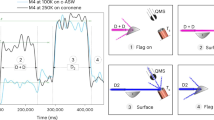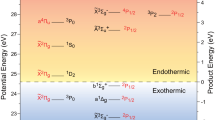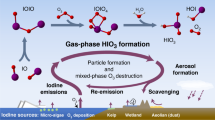Abstract
The discovery in 1986 of an extremely large concentration (∼1 part per 109) of chlorine monoxide (CIO) at low altitudes in the spring stratosphere over Antarctica1,2, and measurements showing the formation of OC1O at night3, provided strong evidence that the evolution of the Antarctic ozone 'hole9 is chemically driven by chlorine. Here we use new measurements4 of the low-altitude CIO profile, made during September 1987, along with detailed observa-tions of ozone depletion5 over McMurdo Station during the same period, to show that both the rate and altitude range of ozone depletion can be quantitatively accounted for by a mechanism in which the CIO dimer6 is the important intermediary in the catalytic destruction of ozone. An alternative bromine mechanism appears capable of contributing only 5–15% to the ozone loss rate.
This is a preview of subscription content, access via your institution
Access options
Subscribe to this journal
Receive 51 print issues and online access
$199.00 per year
only $3.90 per issue
Buy this article
- Purchase on Springer Link
- Instant access to full article PDF
Prices may be subject to local taxes which are calculated during checkout
Similar content being viewed by others
References
De Zafra, R. L. et al. Nature 328, 408–411 (1987).
Solomon, P. M. et al. Nature 328, 411–413 (1987).
Solomon, S., Mount, G. H., Sanders, R. W. & Schmeltekopf, A. L. J. geophys. Res. 92, 8329–8338 (1987).
De Zafra, R. L. et al. J. geophys. Res. (in the press).
Hofmann, D. J., Harder, J. W., Rosen, J. M., Hereford, J. V. & Carpenter, J. R. J. geophys. Res. (in the press).
Molina, L. T. & Molina, M. J. J. phys. Chem. 91, 433–436 (1987).
Molina, M. & Rowland, F. S. Nature 249, 810–814 (1974).
McElroy, M. B., Salawitch, R. J., Wofsy, S. F. & Logan, J. A. Nature 321, 759–762 (1986).
McKenzie, R. L. & Johnson, P. V. Geophys. Res. Lett. 11, 73–75 (1984).
McCormick, M. P. & Larsen, J. C. Geophys. Res. Lett. 13, 1280–1283 (1986).
Mount, G. H., Sanders, R. W., Schmeltekopf, A. L. & Solomon, S. J. geophys. Res. 92, 8320–8328 (1987).
Farmer, C. B., Toon, G. C., Schaper, P. W., Blairer, J.-F. & Lowes, L. L. Nature 329, 126–130 (1987).
Twomey, S., Herman, B. & Rabinoff, R. J. atmos. Sci. 34, 1085–1090 (1977).
Atmospheric Ozone 1985 (Rep. No. 16 of the WMO Global Ozone Research and Monitoring Project) (World Meteorological Organization, 1986).
Cox, R. A. & Hayman, G. D. Nature 332, 796–800 (1988).
Solomon, S., Sanders, R. W., Carroll, M. A. & Schmeltekopf, A. I. J. geophys. Res. (in the press).
Hofmann, D. J., Rosen, J. M., Harder, J. W. & Hereford, J. V. J. geophys. Res. (in the press).
Hayman, G. D., Davies, J. M. & Cox, R. A. Geophys. Res. Lett. 13, 1347–1350 (1986).
Anderson, J. G. et al. J. geophys. Res. (in the press).
Sanders, R. W., Solomon, S., Carroll, M. A. & Schmeltekopf, A. L. J. geophys. Res. (in the press).
Carroll, M. A., Sanders, R. W., Solomon, S. & Schmeltekopf, A. L. J. geophys. Res. (in the press).
Sander, S. P. & Watson, R. T. J. phys. Chem. 85, 4000–4007 (1981).
Brune, W. H. & Anderson, J. G. J. geophys. Res. (in the press).
Hills, A. J., Cicerone, R. J., Calvert, J. G. & Birks, J. W. Nature 328, 405–408 (1987).
Sander, S. P. & Friedl, R. R. Geophys. Res. Lett. 15, 887–890 (1988).
Author information
Authors and Affiliations
Rights and permissions
About this article
Cite this article
Barrett, J., Solomon, P., de Zafra, R. et al. Formation of the Antarctic ozone hole by the CIO dimer mechanism. Nature 336, 455–458 (1988). https://doi.org/10.1038/336455a0
Received:
Accepted:
Issue Date:
DOI: https://doi.org/10.1038/336455a0
This article is cited by
-
Molecular dynamics investigations of chlorine peroxide dissociation on a neural network ab initio potential energy surface
Theoretical Chemistry Accounts (2012)
-
A refined evaluation of the gas-phase dimerization thermodynamics of the ClO radical
International Journal of Thermophysics (1992)
-
Progress towards a quantitative understanding of Antarctic ozone depletion
Nature (1990)
-
Photoisomerization of OCIO: a possible mechanism for polar ozone depletion
Nature (1989)
-
Dynamics weaken the polar hole
Nature (1988)
Comments
By submitting a comment you agree to abide by our Terms and Community Guidelines. If you find something abusive or that does not comply with our terms or guidelines please flag it as inappropriate.



